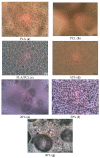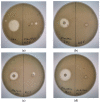A Novel Approach for Glycero-(9,10-trioxolane)-Trialeate Incorporation into Poly(lactic acid)/Poly(ɛ-caprolactone) Blends for Biomedicine and Packaging
- PMID: 38201793
- PMCID: PMC10780447
- DOI: 10.3390/polym16010128
A Novel Approach for Glycero-(9,10-trioxolane)-Trialeate Incorporation into Poly(lactic acid)/Poly(ɛ-caprolactone) Blends for Biomedicine and Packaging
Abstract
The product of ozonolysis, glycero-(9,10-trioxolane)-trioleate (ozonide of oleic acid triglyceride, [OTOA]), was incorporated into polylactic acid/polycaprolactone (PLA/PCL) blend films in the amount of 1, 5, 10, 20, 30 and 40% w/w. The morphological, mechanical, thermal and antibacterial properties of the biodegradable PLA/PCL films after the OTOA addition were studied. According to DSC and XRD data, the degree of crystallinity of the PLA/PCL + OTOA films showed a general decreasing trend with an increase in OTOA content. Thus, a significant decrease from 34.0% for the reference PLA/PCL film to 15.7% for the PLA/PCL + 40% OTOA film was established using DSC. Observed results could be explained by the plasticizing effect of OTOA. On the other hand, the PLA/PCL film with 20% OTOA does not follow this trend, showing an increase in crystallinity both via DSC (20.3%) and XRD (34.6%). OTOA molecules, acting as a plasticizer, reduce the entropic barrier for nuclei formation, leading to large number of PLA spherulites in the plasticized PLA/PCL matrix. In addition, OTOA molecules could decrease the local melt viscosity at the vicinity of the growing lamellae, leading to faster crystal growth. Morphological analysis showed that the structure of the films with an OTOA concentration above 20% drastically changed. Specifically, an interface between the PLA/PCL matrix and OTOA was formed, thereby forming a capsule with the embedded antibacterial agent. The moisture permeability of the resulting PLA/PCL + OTOA films decreased due to the formation of uniformly distributed hydrophobic amorphous zones that prevented water penetration. This architecture affects the tensile characteristics of the films: strength decreases to 5.6 MPa, elastic modulus E by 40%. The behavior of film elasticity is associated with the redistribution of amorphous regions in the matrix. Additionally, PLA/PCL + OTOA films with 20, 30 and 40% of OTOA showed good antibacterial properties on Pseudomonas aeruginosa, Raoultella terrigena (Klebsiella terrigena) and Agrobacterium tumefaciens, making the developed films potentially promising materials for wound-dressing applications.
Keywords: PLA/PCL blend films; antibacterial activity; ozonide; polycaprolactone; polylactic acid.
Conflict of interest statement
The authors declare no conflicts of interest.
Figures











References
-
- Imre B., Pukánszky B. Compatibilization in bio-based and biodegradable polymer blends. Eur. Polym. J. 2015;49:1215–1233. doi: 10.1016/j.eurpolymj.2013.01.019. - DOI
-
- Formela K., Zedler Ł., Hejna A., Tercjak A. Reactive extrusion of bio-based polymer blends and Composites—Current trends and future developments. Express Polym. Lett. 2018;12:24–57. doi: 10.3144/expresspolymlett.2018.4. - DOI
-
- Noroozi N., Schafer L.L., Hatzikiriakos S.G. Thermorheological properties of poly(ε-caprolactone)/polylactide blends. Polym Eng Sci. 2012;52:2348–2359. doi: 10.1002/pen.23186. - DOI
-
- Patrício T., Glória A., Bártolo P. Mechanical and biological behavior of PCL and PCL/PLA scaffolds for tissue engineering applications. Chem. Eng. Trans. 2013;32:1645–1650. doi: 10.3303/CET1332275. - DOI
LinkOut - more resources
Full Text Sources

